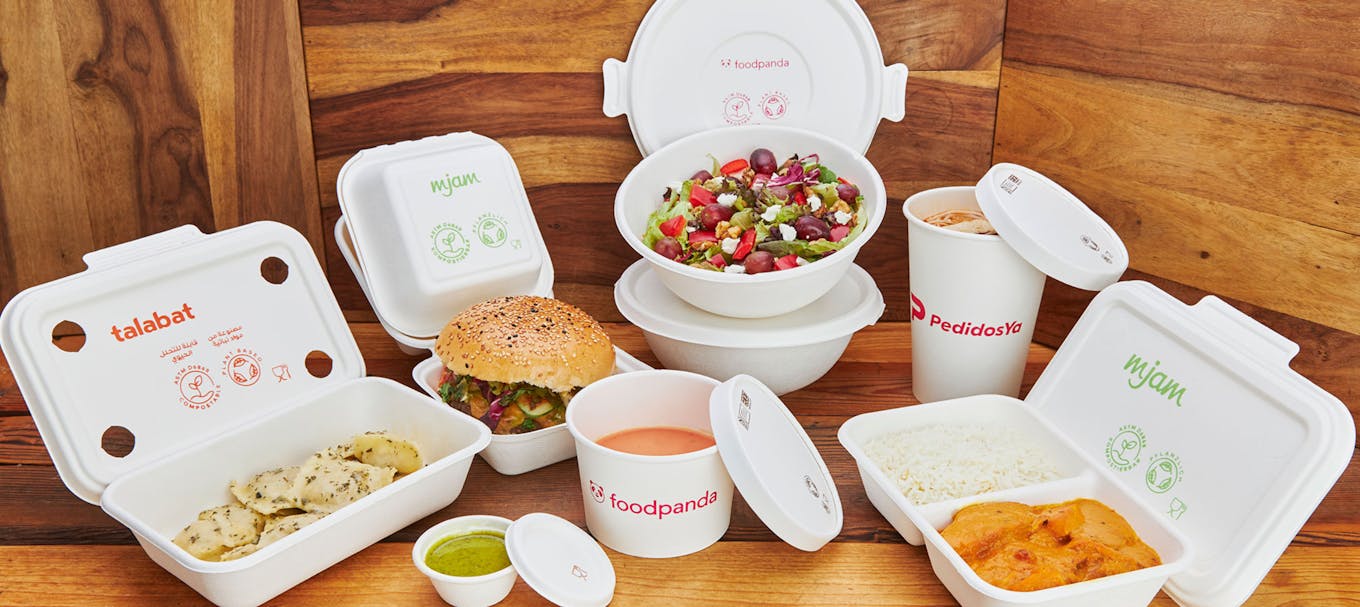While much of the corporate world is struggling amid a persistent pandemic, business has been pretty good for food delivery companies.
To continue reading, subscribe to Eco‑Business.
There's something for everyone. We offer a range of subscription plans.
- Access our stories and receive our Insights Weekly newsletter with the free EB Member plan.
- Unlock unlimited access to our content and archive with EB Circle.
- Publish your content with EB Premium.
Delivery Hero, or Foodpanda as the company is known in Asia, boasted in August that in the second quarter of 2021, it processed 730 million orders — 79 per cent more than a year ago — delivering food worth US$9.8 billion to the millions of customers it services in 50 markets around the world. It was the tenth consecutive quarter where the Berlin-headquartered firm had achieved around 100 per cent revenue growth.
Meanwhile, the company has also been trumpeting some eye-catching sustainability targets, including achieving carbon neutrality globally by the end of this year and rolling out plant-based compostable packaging to replace single-use plastic for its deliveries.
“
The [IPCC] report empowers people like me to push for bold change.
Jeff Oatham, director, sustainability and CSR, Delivery Hero
Balancing bumper business growth with sustainability is not easy for a company that processes around 100 orders a second, relying mainly on petrol-powered vehicles to distribute food wrapped in disposable packaging. The job of ensuring that Delivery Hero’s heady success does not cost the planet falls to Jeff Oatham, who joined the firm in 2019, and has built the company’s sustainability function from scratch. Oatham has worked in senior sustainability roles for the likes of British postal service Royal Mail, data marketing firm Experian, and sustainability consultancy Corporate Citizenship.

Jeff Oatham, director of sustainability and CSR, Delivery Hero
In an interview with Eco-Business, Oatham talks about the industry imperative to disconnect business growth from emissions growth, why Delivery Hero is buying carbon offsets before reducing its carbon exposure, and what the recent alarming Intergovernmental Panel on Climate Change (IPCC) report means to him.
How do the sustainability challenges that Delivery Hero faces compare with those of other companies you’ve worked for?
Even though I have worked across many different sectors, there are common problems, like climate change and waste that all companies are facing. But in each role there are unique opportunities. What stands out at Delivery Hero is that it is an ambitious company in an ambitious sector. We are seeing hyper growth on the commerical side, but there is also a clear desire to have positive impact — and the company is putting serious resources behind driving change. The other aspect is that we are able to connect with a large number of people who are using the product [the apps] on a daily basis.
What effect has the latest IPCC report, which predicts no end to rising temperatures before 2050 unless greenhouse gas emissions are slashed, had on you and your role at Delivery Hero?
The headline [from the report] confirms what a lot of us already knew — that we need to take action now. One of the main things it is telling us is that there is strong science backing the need to change, and that’s a major step change from previous reports, where the IPCC was more cautious. That caution has now gone. The report empowers people in roles like mine to be able to push for bold change.
How has Delivery Hero’s business growth increased in line with the company’s carbon emissions trajectory?
I can’t comment specifically on how the emissions have changed, because we are still measuring our global greenhouse gas footprint. But I would expect an increase in emissions. This highlights the challenge for any fast-growing delivery company — how do you disconnect business growth from emissions? That’s the big challenge the industry needs to solve over the next decade, in response to what the IPCC report is telling us.
How would you say that Delivery Hero is faring relative to its competitors, which in Asia include Grab and Gojek?
We look to what our peers are doing more for sense-checking our own approach rather than looking for ways to differentiate ourselves and see who is ahead of us. We need to take on challenges like climate change and waste as an industry. That said, Gojek and Grab seem to be focusing more on transport while we are focusing more on food and packaging as a means to reduce our footprint. The vision we’re setting out for Delivery Hero is how we can drive change through the food and delivery ecosystem — it isn’t just about us. We need to bring our restaurant and vendor partners with us.
Delivery Hero is aiming to be carbon neutral globally by the end of 2021. How far is the company towards meeting that goal, and how much will this rely on buying carbon offsets? Also, why are you offsetting carbon before reducing it?
We are on track to achieve carbon neutrality globally by the end of this year. We have, admittedly, taken a different approach [to decarbonisation] by first measuring our carbon footprint, then offsetting, then pivoting to reduction. We’ve done it in that order purposely, and by region. We have measured our carbon footprint in Europe and Latin America and have offset the footprint of those operations. The Middle East and Asia Pacific will be next.
We will be carbon neutral almost exclusively through offsetting. The reason we’ve done it this way is to address our emissions right away while we take the time to figure out how to reduce them at scale. The environmentalist in me is saying that you should measure, reduce, and then offset what you can’t reduce. But reducing emissions across 50 markets is a complex business. Looking at transport alone, the regulatory environment will differ considerably in each of those different countries, so figuring out how to reduce [carbon] will take time.

Delivery Hero’s approach to decarbonisation. Offsetting first, reduction later. Image: Delivery Hero Sustainability
How did you go about choosing the offsets that you’ve chosen?
We won’t invest in a project that doesn’t meet certain standards, and we look for projects that are varied in terms of the technology used and where they are located [Delivery Hero’s offset projects include solar and wind projects in India, and are managed by climate solutions provider South Pole].
Other players have enabled consumers to offset their delivery orders. Is this something you’d consider too?
If we were to have involved the consumer, there would’ve been no guarantee that the deliveries would have been offset, and we wouldn’t have been able to claim carbon neutrality. We have chosen to take responsibility and offset [the carbon footprint] ourselves.
That said, engaging consumers on sustainability is going to be critical to addressing the challenges the industry faces. In Europe, we launched the Sustainable Restaurant Certification Programme, which rates the sustainability credentials of restaurants in the app. We wanted to see if sustainability ratings would influence consumer behaviour. We saw some postive results from that, but it was a small pilot. We need to see how we can build on that. Being a tech company with millions of customers using our apps every day, we have an opportunity to engage consumers and give them sustainable choices.
What element of the carbon footprint will you reduce first?
First, any carbon reduction programme needs to be driven by targets, and we’re working on those at the moment. From the regions where we’ve measured our footprint, it’s not surprising to find that deliveries makes up a significant part of our footprint, and packaging plays a big role in that. For instance, the carbon intensity of plastic packaging is about 100 times that of compostible plant-based packaging, which we are rolling out around the world as part of our global Sustainable Packaging Programme.
The Sustainable Packaging Programme aims deploy 10 million units of 100 per cent plant-based and perfluoroalkoxy-alkanes (PFAS) free alternatives to plastic packaging by the end of 2022. Why are you focusing on packaging first and not reducing emissions from transport?
There wasn’t a decision to go for packaging over transport [in tackling the carbon footprint], it’s just that we had started looking at packaging a few years ago, and we wanted to bring these efforts together in a more targeted and strategic programme.
We had also guessed that packaging was going to be a sizable portion of the footprint, and that has shown to be true in the data. We also saw that sustainable packaging was a solution that could scale. Whatever the issue, we are going to need to find solutions that scale across very different operating environments.

Delivery Hero’s Sustainable Packaging Program uses plant-based compostible packaging for food deliveries. Image: Delivery Hero
Packaging of any kind is not ‘sustainable’ in countries like Singapore, which incinerates almost all of its waste. Why hasn’t Delivery Hero done more to pursue reusable packaging solutions, which you have trialled with food container sharing services BarePack and Muuse in Singapore in response to the masses of single-use packaging waste created during Covid lockdowns (Delivery Hero has declined to share data on the uptake of the BarePack and Muuse programme, but said that it is a “long-term programme and not a trial”)?
Different solutions are needed for different markets, but we are seeing that single-use compostable packaging is much more scalable than reusable packaging. It is very difficult to scale reusable solutions outside of individual markets, or even outside of individual cities, because it requires extensive local infrastructure to work.
I think the jury is out on the environmental benefits of compostable versus reusable solutions, and we’re thinking of introducing some reusable pilot schemes in other countries to understand better what will work best in those markets. No solution will be absolutely perfect. But what we can say is, there are benefits of single-use compostable packaging versus single-use plastic, at least in an element of its lifecycle.
Can’t you tweak the app so that consumers are offered the more sustainable food choices first?
We’re trying that idea with the Sustainable Restaurant Certification Programme. The challenge is ensuring that whatever approach we take is actually materially impactful and authentic. The last thing that we would want is to slap a [sustainability] icon on a restaurant, and it is perceived as greenwashing. We need to get the detail and methodology right first, and across a range of different restaurants and markets, before communicating to the customer.














